Vahdat Hall | Tehran's Cultural Elegance and Artistry
Located in the heart of Tehran, Vahdat Hall (تالار وحدت) stands as an enduring testament to the rich tapestry of Iran's cultural heritage.
Originally known as Rudaki Hall, this architectural masterpiece underwent a transformative journey over the years, evolving into the iconic Vahdat Hall we know today. The Vahdat Hall Tehran's history is etched with significance, tracing back to its construction between 1957 and 1967 by the visionary architect Eugene Aftandilian, inspired by the grandeur of the Vienna State Opera. In 1967, former king Mohammad Reza Pahlavi inaugurated the hall with the performance of "The Rustic Festival," marking the beginning of a cultural legacy. Today, Vahdat Concert Hall is a beacon of artistic brilliance, drawing audiences with its symphonies, operas, and ballets. From its semi-circular balconies adorned with Achaemenid-style plasterwork to the honeycomb convex ceiling and crystal chandeliers, Vahdat Hall's architectural splendor resonates with tales of grandeur. This cultural haven, located on Hafez St., Ostad Shahryar St., not only captivates with its structural magnificence but also beckons visitors with promises of unforgettable cultural experiences.
Vahdat Hall Historical Journey
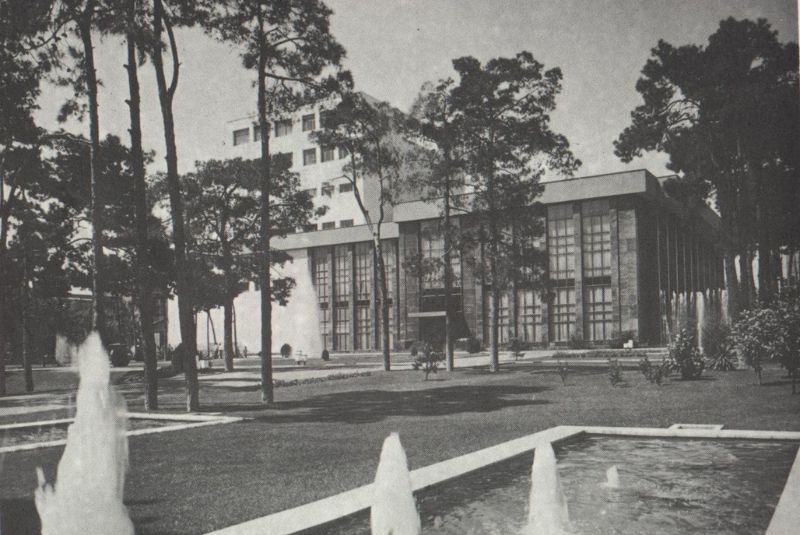
Embarking on a journey through time, the roots of Vahdat Hall trace back to the late 1950s when construction commenced on what would become an architectural marvel. The visionary architect Eugene Aftandilian, drawing inspiration from the illustrious Vienna State Opera, orchestrated the design of this cultural bastion. Over the course of a decade, from 1957 to 1967, the hall took shape on Ostad Shahryar Street, formerly Dr. Arfa, manifesting Aftandilian's vision into a grand reality.
The hall's completion marked a significant moment in Iranian cultural history. In 1967, the inaugural performance echoed through the grandeur of Vahdat Hall. Former king Mohammad Reza Pahlavi presided over the opening night, where "The Rustic Festival," the first Persian opera composed by Ahmad Pejman, graced the stage. Two weeks of international performances marked the coronation festivities, cementing Vahdat Hall as a national stage for music, opera, and ballet.
Following the Islamic Revolution, the hall underwent a metamorphosis, reflecting the cultural shifts within the nation. Vahdat Hall, once known as Rudaki Hall, assumed its current name as a nod to the Persian word for "unity." This renaming occurred during the week of unity and celebrations for the birth of the Prophet of Islam, marking a symbolic transition for this cultural beacon. Despite the political changes, Vahdat Hall continued to flourish as a hub for artistic expression.
The history embedded in the walls of Vahdat Hall tells a tale of resilience, adaptation, and cultural continuity. From its initial construction to the transformative years post-revolution, the hall's legacy reflects the dynamic narrative of Iran's cultural evolution. Today, Vahdat Hall stands not only as a testament to architectural ingenuity but also as a symbol of unity, transcending time and political epochs to embrace the ever-evolving spirit of Iranian artistry.
| Suggestion: Tehran City Theater
Vahdat Hall Architecture
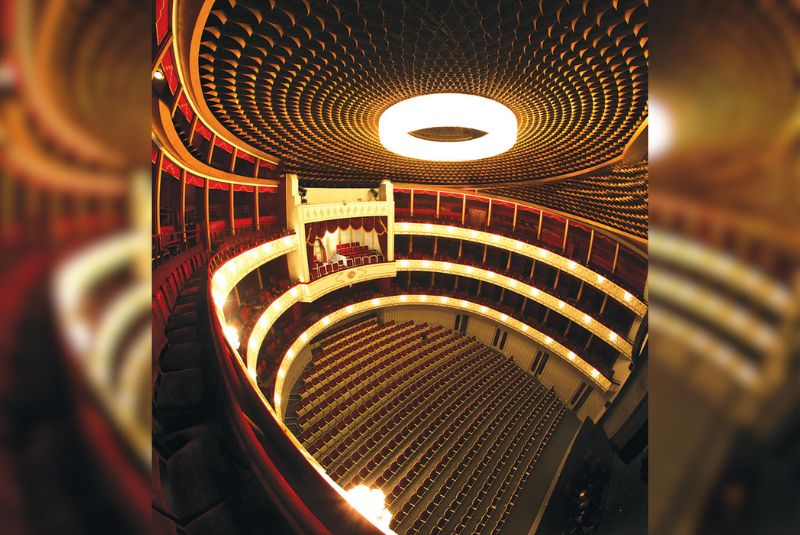
Vahdat Hall, nestled in Tehran, unfolds as an architectural marvel that seamlessly intertwines historical opulence with contemporary allure. The design, a brainchild of visionary architect Eugene Aftandilian, mirrors the grandeur of the Vienna State Opera. One cannot escape the magnetic pull of the semi-circular balconies that embrace the audience, creating an intimate connection between performers and spectators. These tiers, adorned with Achaemenid-style plasterwork, speak to Iran's storied past, each detail a brushstroke in the canvas of cultural continuity.
As the gaze ascends, the honeycomb convex ceiling steals the spotlight. Beyond mere aesthetics, it symbolizes the layered complexity of Iran's cultural heritage. The intricate pattern, reminiscent of the Achaemenid era, captivates with its historical homage. A journey through Vahdat Hall is, in essence, a walk through time—an exploration of architectural elements that transcend eras.
The hall's artistic tapestry extends to crystal chandeliers that cast an enchanting glow on the proceedings. This sophisticated lighting scheme, combined with Achaemenid-inspired plasterwork, transforms Vahdat Hall into a living testament to Persian elegance.
Descending into the heart of the hall, Rudaki Hall, on the third floor, unfolds as a sanctuary for artistic expression. With a capacity for 200, it hosts symphony orchestra rehearsals and intimate musical performances. The main hall itself is a spectacle of grandeur. Its ground floor and three balcony levels accommodate over 700 spectators. Crystal wall lights and an imposing ceiling chandelier set the stage for symphonies, operas, and ballets.
Venturing beyond the limelight, backstage floors—seven in total—reveal the hidden mechanisms that orchestrate the seamless performances. Here, the third floor houses Rudaki Hall, where the future of musical talent is nurtured. Vahdat Hall, with its multi-layered architecture, not only captivates with its visual splendor but beckons visitors to unravel the stories etched in its walls—a testament to the enduring spirit of Iranian artistry.
| Discover: Persian Architecture
Vahdat Hall Stage and Scene
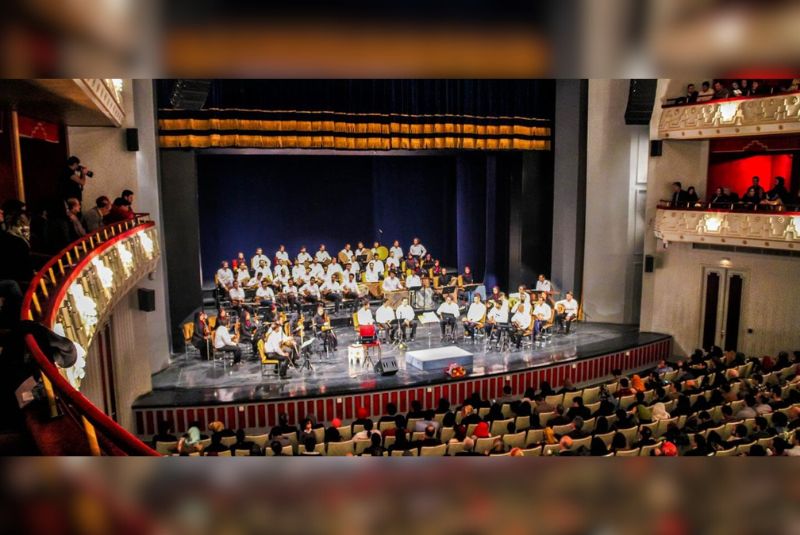
Vahdat Hall's allure extends beyond architectural elegance to its intricately designed stages that serve as canvases for artistic brilliance. The avant-scène, with a standard height of 80 cm, unfolds as a focal point where large orchestras, operas, and musical shows come to life. Its main arch, with a radius of 15 meters, sets the stage for immersive performances, and the left and right lighting slots enhance the visual spectacle.
The main stage, with a width of 12 meters and a depth exceeding 10.30 meters, features three moving stage systems—Podim One (P1), Podim Two (P2), and Podim Three (P3). These systems, capable of moving 1.65 meters deep into the ground and 4.60 meters upwards, provide a dynamic platform for versatile productions. The main stage, complemented by a revolving stage that can rotate left and right at different speeds, showcases the hall's commitment to staging diverse and technically demanding performances.
On the left side of the audience, Vahdat Hall unveils its lateral stage—two sidecar systems on rolling rails. These wagons, with the capacity to carry decorations weighing over two tons, contribute to the hall's reputation for hosting productions of grandeur and scale.
Beyond the visible stages, Vahdat Hall integrates advanced mechanical and electronic systems. German-made systems facilitate the controlled movement of stages, ensuring seamless transitions during performances. The Galileo processor governs the intricate sound system, featuring two main clusters, each with 12 speakers and two subwoofers, providing a robust auditory experience.
With its avant-garde stages and cutting-edge technology, Vahdat Hall stands ready to host large orchestras, opera productions, and a spectrum of cultural performances. This dynamic fusion of traditional grandeur and modern technology positions Vahdat Hall as a premier venue where artistic visions come to life on a stage designed for innovation and excellence.
Vahdat Hall Cultural Significance
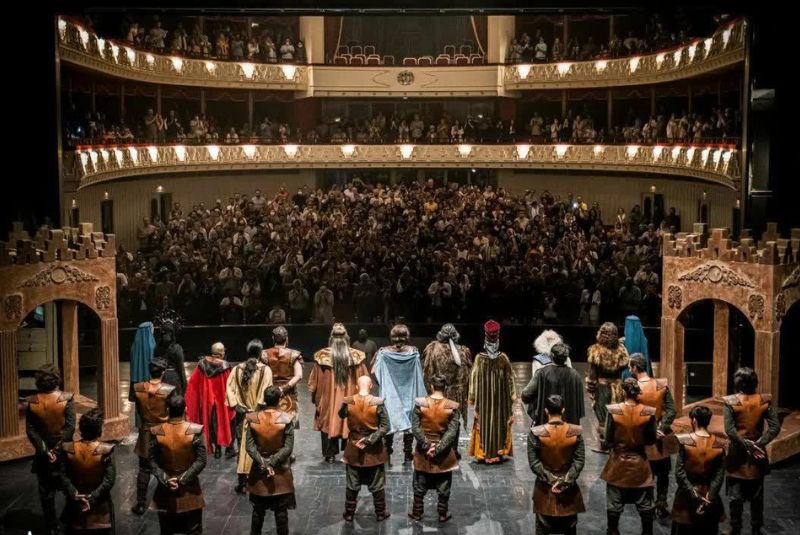
Renowned for its role in hosting a spectrum of events, it has become the beating heart of both national and international cultural festivities. Since its inauguration in 1967, the hall has been a witness to the evolution of Iran's cultural landscape.
The stage of Vahdat Hall has echoed with the timeless notes of opera, the graceful movements of ballet, and the harmonies of classical and contemporary music. It serves as a versatile canvas for artistic expression, with performances ranging from the traditional to the avant-garde. This dynamic range has turned Vahdat Hall into a sanctuary for artists seeking to push the boundaries of their craft.
Over the years, Vahdat Hall has welcomed a procession of celebrated artists and troupes, leaving an indelible mark on its cultural legacy. From the elegant ballet productions to the resonating arias of opera, the hall has played host to luminaries such as Rudolf Nureyev, Margot Fonteyn, and Elisabeth Schwarzkopf. Internationally acclaimed ensembles like the Kirov Ballet and Stuttgart Ballet have graced its stage, contributing to the global recognition of Vahdat Hall as a cultural epicenter.
On the national front, the hall has been a nurturing ground for local talents, providing a platform for the Tehran Symphony Orchestra, Tehran Opera Orchestra, and the Iranian National Ballet Company. The rich tapestry of performances includes not only classical masterpieces but also contemporary creations, ensuring a dynamic and inclusive cultural landscape.
As Vahdat Hall continues to evolve, its commitment to fostering a diverse cultural milieu remains unwavering. It stands not only as a venue for performances but as a living testament to the power of the arts in uniting communities and bridging cultural divides.
| Read more: Cinema Museum of Iran
Vahdat Hall Facilities and Equipment
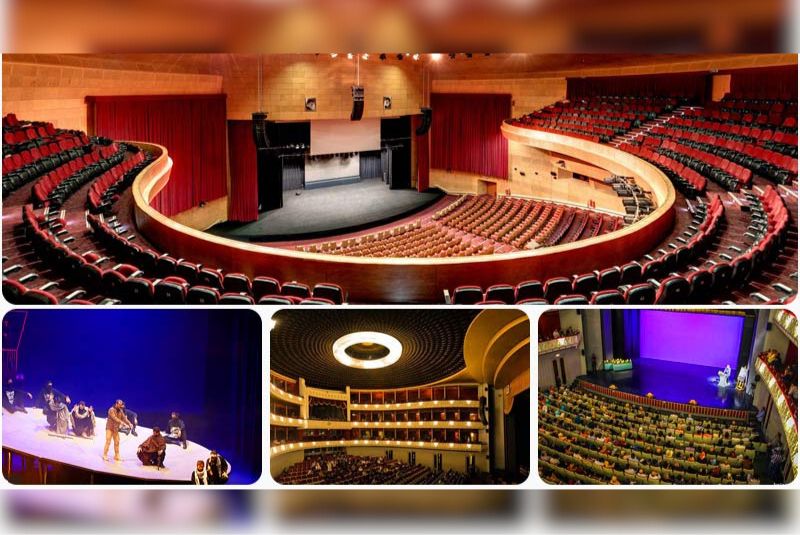
Crafted by ADB in Belgium and licensed by Germany, the lighting system boasts 120 circuits of 2.5 kW, meticulously distributed to illuminate every corner of the hall. The SDB Tenor type light table, equipped with digital memory and a master timer, orchestrates the interplay of light, adding a dynamic layer to every performance.
The audio features at Vahdat Hall are second to none. With a sound system installed and calibrated by the reputable Meyer company, the hall can boast of having one of the best and most advanced audio setups globally. Two main clusters, each consisting of 12 speakers and two subwoofers, deliver a robust auditory experience, complemented by eight smaller speakers strategically placed in the balconies. The Galileo processor takes the reins, ensuring precision and uniformity in sound distribution, creating an acoustic haven for both performers and audiences.
Visual excellence is woven into the fabric of Vahdat Hall, with video facilities capable of filming, projecting, and broadcasting high-quality images. The XF345-XF330 projectors and DVD players contribute to the hall's visual prowess, providing a canvas for dynamic multimedia presentations.
With seven floors dedicated to artists' rooms, offices, and essential operations, Vahdat Hall ensures that every event, from orchestral rehearsals to grand productions, unfolds with precision. The hall's expansive capacity, coupled with its cutting-edge facilities, positions it as a versatile venue capable of hosting a myriad of events, each infused with the technological wizardry that defines Vahdat Hall's commitment to excellence.
| Discover: Tehran Time Museum
Vahdat Hall Access and Location
Located between Ferdowsi and Teatreshahr metro stations on Tehran Metro Line 4, reaching Vahdat Hall is as straightforward as it is convenient. Alighting at Teatreshahr station, a short stroll eastward through Student Park and along Ostad Shahriar Street leads you to the grand entrance of Vahdat Hall.
The address, Ostad Shahryar St., places Vahdat Hall at the heart of Tehran's cultural tapestry, easily accessible via the bustling metro line and surrounded by the vibrant energy of the surrounding area. BRT bus lines, including Azadi Square-Tehranpars, Railway-Tajrish, and Railway-Parkway, make it even more accessible for those opting for a bus journey. Vahdat Hall's strategic location is not just an address; it's an invitation to immerse yourself in Tehran's cultural hub with unparalleled ease.
Vahdat Hall Visitor Experience
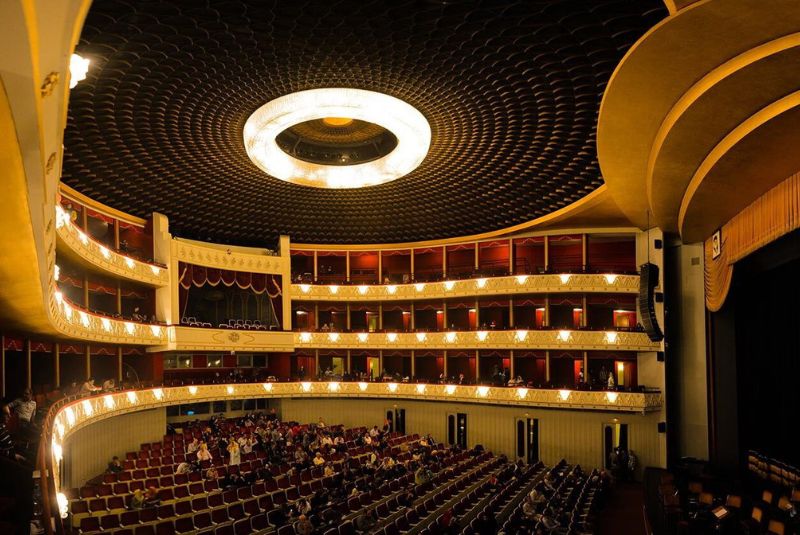
Stepping into Vahdat Hall is not just attending a performance; it's immersing oneself in an artistic odyssey. The main hall, a testament to architectural ingenuity, accommodates over 700 spectators in a setting that marries comfort with aesthetic delight. The semi-circular balconies adorned with Achaemenid-style plasterwork and a honeycomb convex ceiling enhance the visual experience, setting the stage for an unforgettable spectacle.
The audience is not merely a spectator; they become part of the artistic atmosphere meticulously crafted within Vahdat Hall. The special cabins and balconies, numbering 20 on the west and east sides, offer an exclusive vantage point, allowing patrons to indulge in performances with an added touch of luxury. The plush decor, crystal wall lights, and a grand ceiling chandelier create an ambiance that transcends the ordinary, ensuring each visit is a sensorial delight.
Beyond the main hall, the side halls of Vahdat Hall unfold an opportunity for more than just performances. With significant capacity, these spaces become a canvas for art exhibitions and unique presentations, adding another layer to the multifaceted experience. Vahdat Hall isn't just a venue; it's a haven where every spectator becomes a participant in the symphony of artistic expression, fostering a connection that lingers long after the curtains fall.
| Also might be interesting: Frieze of Archers | A Leagacy of Persian Empire
Finally!
In the heart of Tehran, Vahdat Hall stands not just as a venue but as a testament to a rich history, architectural brilliance, and a cultural legacy that continues to unfold. This cultural gem invites you to explore its grandeur, promising an experience that transcends the ordinary. From historical echoes to architectural marvels and a stage that hosts the world's finest, Vahdat Hall is a canvas where elegance meets artistry. Embrace the magic of its performances, where every note, every movement, becomes a thread in the rich tapestry of Iran's cultural heritage. Vahdat Hall awaits, beckoning you to witness the symphony of the ages.
Share your story!
Comment below and let us know about your Experience.
Your story inspires others!


Comment
Leave a Comment